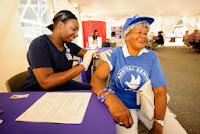Negative stories about vaccines dominate the news, as
activist groups continue to spread misinformation. But, vaccines are important
to our health and safety, and many are speaking out about their positive
effects.
NASCAR driver Jeff Gordon
joined the Sounds of Pertussis campaign with the March of Dimes and Sanofi Pasteur. The campaign is a national
education program educating adults about the importance of getting an adult
Tdap (tetanus, diptheria and acellular pertussis) vaccination. The booster
vaccine prevents adults from contracting pertussis and passing it along to
unvaccinated infants, who will receive the vaccine at two months of age.
The Centers for Disease Control and Prevention (CDC)
reported there were more than 41,000 cases and 18 deaths reported in 2012 for
pertussis, the largest outbreak in fifty years.
“Eighty percent of the time…these young infants are getting
it from family members so it’s really about prevention (efforts),” Gordon
states. “Prior to the baby being born, family members, when they come to the
hospital, when they come to the home to visit, you know they need to make sure
they’re protected.”
Gordon is not the only person speaking in favor of vaccines.
Jeanne Sager wrote an
impassioned blog post for The Stir about the importance of vaccines. She asks parents to
also consider all of the diseases that vaccines prevent, rather than just
focusing on vaccine safety.
Sager references Amy Parker’s story on Voices for Vaccines.
Parker grew up un-vaccinated in a “health nut” family. Parker states:
As healthy as my lifestyle seemed, I
contracted measles, mumps, rubella, a type of viral meningitis, scarlatina,
whooping cough, yearly tonsillitis, and chickenpox, some of which are vaccine
preventable. In my twenties I got precancerous HPV and spent 6 months of my
life wondering how I was going to tell my two children under the age of 7 that
mummy might have cancer before it was safely removed...
If you’ve never had these illnesses
you don’t know how awful they are -- I do. Pain, discomfort, the inability to
breathe or to eat or to swallow, fever and nightmares, itching all over your
body so much that you can’t stand lying on bed sheets, losing so much weight
you can’t walk properly, diarrhea that leaves you lying prostrate on the
bathroom floor, the unpaid time off work for parents (and if you’re self
employed that means NO INCOME), the quarantine, missing school, missing
parties, the worry, the sleepless nights, the sweat, the tears and the blood,
the midnight visits to
A
and E, sitting in a doctor’s waiting room on your own because no one will
sit near you because they’re rightfully scared of those spots all over your
kid's face.
Dr. Daniel Gilstrap of Durham, North Carolina notes that,
“The list of vaccines for adults has expanded quite a lot in the last few
years. Not only that, the knowledge of the safety of these vaccines has
increased.”
Vaccination efforts have enabled entire generations to grow
up without knowledge of the severity of
polio, measles, whooping cough, and
others. Gilstrap and other physicians are working to educate people on the
importance of vaccines because they don’t know how bad the diseases can be.
Finally, Lisa Murakami wrote a blog post last September,
Vaccination: A Layperson’s Perspective. Her post generated 482 comments and
tackles all of the vaccination myths.
Her husband is a medical resident at Dana Farber.
She notes, “That means, he has 14.5 years of grueling
medical training that I don’t have. And – conservatively estimated – 28,160
hours. My father has infinitely more; he’s seen tens of thousands of patients
over the course of his forty-year career as a pediatrician. Clearly, I can’t
run a Google search on a complex medical topic and eventually cobble together a
better answer on it than these two can.”
Murakami concludes by noting that she can’t link to many of
the sources she used when debunking vaccine myths because you have to pay for a
subscription to major medical journals and other legitimate scientific sources.
She has subscriptions to these sources, but the average person does not. The
best information on vaccines isn’t available by Googling the Internet, however
the worst information is available.
Those with questions about vaccines should consult their
pediatrician. The Internet and other sources is not a substitute for years of
medical training, and the diseases are much worse than the vaccines.




.JPG)





